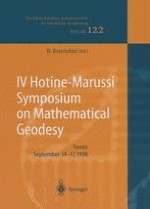2001 | OriginalPaper | Buchkapitel
A Global Topographic-Isostatic Model Based on a Loading Theory
verfasst von : Wenke Sun, Lars E. Sjöberg
Erschienen in: IV Hotine-Marussi Symposium on Mathematical Geodesy
Verlag: Springer Berlin Heidelberg
Enthalten in: Professional Book Archive
Aktivieren Sie unsere intelligente Suche, um passende Fachinhalte oder Patente zu finden.
Wählen Sie Textabschnitte aus um mit Künstlicher Intelligenz passenden Patente zu finden. powered by
Markieren Sie Textabschnitte, um KI-gestützt weitere passende Inhalte zu finden. powered by
This a preliminary report of our ongoing research on a global topographic-isostatic model. The model originates from a completely new idea—the geoid undulation is the response of an elastic earth to topographic mass load. Assuming the topography as a condensed surface mass load, we derive expressions for calculating the vertical displacement, potential and equipotential surface changes, based on the load theory proposed in (1996). We also discuss the mass conservation problem and some calculating techniques. The modeled geoid is composed of three parts: loading potential, surface displacement and mass redistribution. The surface displacement and mass redistribution of the earth compensate to some extent the topography. In practical calculations we adopt the Getech’s Global Digital Terrain Model with 5x5 minute bloc averages (DTM5). Using the load Love numbers and Green’s functions obtained from the 1066A earth model, we calculate and discuss the vertical displacements and equipotential surface changes for depths: earth’s surface, d = 36 km and the core-mantle boundary. Numerical results show that the displacements at depth 36 km and the earth surface have the same distribution pattern and magnitude, while the vertical movement of the core-mantle boundary appears much smoother and smaller. The contribution of the mass redistribution to the equipotential surfaces is rather small and smooth. The modeled geoid undulations at the earth’s surface caused by the topographic mass load vary between-352 and +555 m. Comparing the modeled and observed geoid undulations shows that there are strong positive correlations between them, but a compensation only by elastic deformations is not sufficient to explain the observed undulations because of the big difference in magnitude between the two geoids. More geodynamic effects should be considered to better explain the long-wavelength geoid features.
